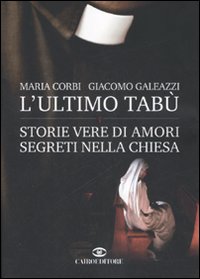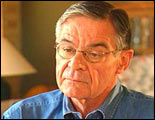|
The
Priesthood in Italy
Maria Corbi & Giacomo
Galeazzi,
L’ultimo tabý. Storie vere di amori segreti nella chiesa,
Cairoeditore, Milano: 2007,
Pp. 237.
THE LAST TABOO:
True Stories About
Secret Love in The Church
 Corbi and Galeazzi are journalists
who met and interviewed the priests and religious they write about. They
collected a dozen “love stories.” The authors retain the real names and
places in some instances in other cases they disguise identities, but all
the stories are true and set in Italy. The book is not anti Catholic. It
is simply a report about some problems and sufferings of vowed celibates
falling in love. The theme is reminiscent of Jane Anderson’s account of
Priests in Love
in Australia. The authors group their accounts into five sections. Corbi and Galeazzi are journalists
who met and interviewed the priests and religious they write about. They
collected a dozen “love stories.” The authors retain the real names and
places in some instances in other cases they disguise identities, but all
the stories are true and set in Italy. The book is not anti Catholic. It
is simply a report about some problems and sufferings of vowed celibates
falling in love. The theme is reminiscent of Jane Anderson’s account of
Priests in Love
in Australia. The authors group their accounts into five sections.
Part I. Here the authors report on
the biographies of three couples and married love:
All the characters are well known
from the Italian media and Internet. The men—who have left the priesthood
to marry—and their wives recount their stories without disguising their
identity. Together they tell the stories of how they met, the prelude and
the consequences of their relationships. Without hesitation they speak
about the good they discovered and the difficulties they endured. From a
certain point of view these are stories with happy endings, or to use
Andrew Greeley’s mindset, “comedies of grace.”
Part II. This section contains three
dramatic stories about difficult love:
First: Claudio and Lucia are members
of Legionaries of Christ. After falling in love they conducted their
clandestine affaire de coeur in hotels and hide-a-ways.
Lucia, overcome by a sense of guilt, struggled to quit the relationship
and left. Both suffered in the break up, but each solved the pain in
different ways. Lucia, like Heloise, decided to renew her celibate
obligation and life. Claudio, although very unhappy in the order,
continues living with his religious community, but waits and hopes for
another love.
Second: JÚzef is a priest and
teacher. Helena is his student. Their relationship was special. In
symbiosis, he became the master and she the disciple. When he received a
promotion to Rome she went with him. Still her patron, he found her a job
and a suitable apartment. Father JÚzef was the celebrant at her wedding.
But the marriage was a failure and ended; she was not able to have a
normal sexual life with her husband. The dependent relationship with
Father Jůzef continues and flourishes.
Third: Claudio is a parish priest
who met Camila, a lonely mother, through the Internet. After some time
they began meeting in her apartment and sleeping together. The
relationship is enduring and satisfying, but Father Claudio has never told
Camila that he is a priest and serves a parish. He presents himself as a
married man whose marriage is in crisis. He has the intention to talk with
her about his situation without saying the he is “married to the church.”
Part III. Here
the authors tell two stories about rejected love:
The first priest is a chaplain in a
convent of nuns. During spiritual direction he becomes attracted to a
novice and she is enamored with him. In spite of the mutual attraction he
is unable to sustain this kind of relationship. The young novice tries to
sublimate her feelings. But as the feelings build she tries to express her
affection for him, but he is the one overcome by emotion. The priest has
a crisis, faints and ends up in hospital. The novice transfers to another
monastery to continue her training.
The second story is the account of a
young and gifted priest teaching religion at a high school. He falls in
love with one of his pupils and she with him. Little by little they
develop a sexual relationship. It was easier for the girl to get into the
affair than out of it. When she wants to be free from the priest it
becomes even more complicated and seems impossible. Even the parents
cannot do anything to extricate their daughter. The administration of the
catholic school protects and defends the priest. The girl is forced to
move to another city and change schools.
Part IV. Again, two stories are
paired, here dealing with impossible love:
Father Angelo gets into trouble when
the police discover him in flagrante delecto with a transsexual
person. His partner, Emmanuele, came to Italy from Brazil and works as
prostitute. Angelo’s crisis crescendos when he makes a public confession
to his parish.
Father Robert is a homosexual who
tells his story of struggles, defeats, and success. It is a classical
tale, but a story infrequently exposed or affirmed by Catholic priests.
Part V. The authors finally enter
into a more theoretical dialogue:
Former priest Carlo Vaj, a professor
of Diandra University (Phoenix) and author of Totem e il Briccone
talks about his interesting interpretation of the psychological profile of
a priest/religious that make use of dreams. The content and tone reminds
one of the works of Eugen Drewermann.
Giovanni Franzoni is the former Abbot
of the Benedictine monastery of St. Paul Outside the Walls in Rome. He
does not consider obligatory celibacy the main problem for the church or
the priesthood. The major problem is truth and honesty. He highlights that
the first step toward solving the sexual crisis today would be that
priests who are living sexually active lives should be obligated to
acknowledge it. They should officially and legally recognize the woman
they are with, take care of her and their children.
The authors conclude the book with a
short epilogue that includes a dialogue between Giovanni Nicolini
and Antonio Socci.
They debate the issues of celibacy, honesty, and the future of the church.
Jane Anderson, Priests in
Love, Continuum International Publishing, New York: 2005.
Carlo
Vaj, Totem e il Briccone, Ecrg, Genoa: 2005. Vaj continues his
work as a psychotherapist, and professor.
Eugen
Drewermann, theologian and psychotherapist has been the most
significant, prolific and bestselling theological writer in the German
language over the past quarter century. Drewermann shows that
religion, including Christianity, turns violent mentally, spiritually,
and even physically if it uses fear as a motive for faith- fear of
exclusion from the group, fear of hell and fear of God. Cf. The first
full-length introduction to his work in English :Matthais Beier, Ed.
Violent God-Image: An Introduction to the Work of Eugen Drewermann
|



